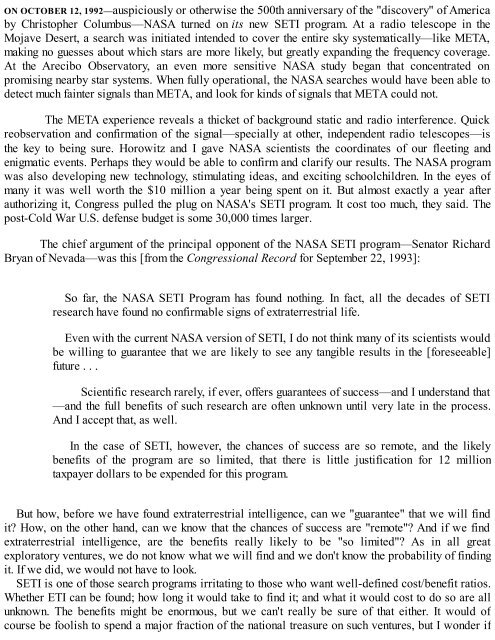Pale Blue Dot ( PDFDrive.com ) (1)
Create successful ePaper yourself
Turn your PDF publications into a flip-book with our unique Google optimized e-Paper software.
ON OCTOBER 12, 1992—auspiciously or otherwise the 500th anniversary of the "discovery" of America<br />
by Christopher Columbus—NASA turned on its new SETI program. At a radio telescope in the<br />
Mojave Desert, a search was initiated intended to cover the entire sky systematically—like META,<br />
making no guesses about which stars are more likely, but greatly expanding the frequency coverage.<br />
At the Arecibo Observatory, an even more sensitive NASA study began that concentrated on<br />
promising nearby star systems. When fully operational, the NASA searches would have been able to<br />
detect much fainter signals than META, and look for kinds of signals that META could not.<br />
The META experience reveals a thicket of background static and radio interference. Quick<br />
reobservation and confirmation of the signal—specially at other, independent radio telescopes—is<br />
the key to being sure. Horowitz and I gave NASA scientists the coordinates of our fleeting and<br />
enigmatic events. Perhaps they would be able to confirm and clarify our results. The NASA program<br />
was also developing new technology, stimulating ideas, and exciting schoolchildren. In the eyes of<br />
many it was well worth the $10 million a year being spent on it. But almost exactly a year after<br />
authorizing it, Congress pulled the plug on NASA's SETI program. It cost too much, they said. The<br />
post-Cold War U.S. defense budget is some 30,000 times larger.<br />
The chief argument of the principal opponent of the NASA SETI program—Senator Richard<br />
Bryan of Nevada—was this [from the Congressional Record for September 22, 1993]:<br />
So far, the NASA SETI Program has found nothing. In fact, all the decades of SETI<br />
research have found no confirmable signs of extraterrestrial life.<br />
Even with the current NASA version of SETI, I do not think many of its scientists would<br />
be willing to guarantee that we are likely to see any tangible results in the [foreseeable]<br />
future . . .<br />
Scientific research rarely, if ever, offers guarantees of success—and I understand that<br />
—and the full benefits of such research are often unknown until very late in the process.<br />
And I accept that, as well.<br />
In the case of SETI, however, the chances of success are so remote, and the likely<br />
benefits of the program are so limited, that there is little justification for 12 million<br />
taxpayer dollars to be expended for this program.<br />
But how, before we have found extraterrestrial intelligence, can we "guarantee" that we will find<br />
it? How, on the other hand, can we know that the chances of success are "remote"? And if we find<br />
extraterrestrial intelligence, are the benefits really likely to be "so limited"? As in all great<br />
exploratory ventures, we do not know what we will find and we don't know the probability of finding<br />
it. If we did, we would not have to look.<br />
SETI is one of those search programs irritating to those who want well-defined cost/benefit ratios.<br />
Whether ETI can be found; how long it would take to find it; and what it would cost to do so are all<br />
unknown. The benefits might be enormous, but we can't really be sure of that either. It would of<br />
course be foolish to spend a major fraction of the national treasure on such ventures, but I wonder if


